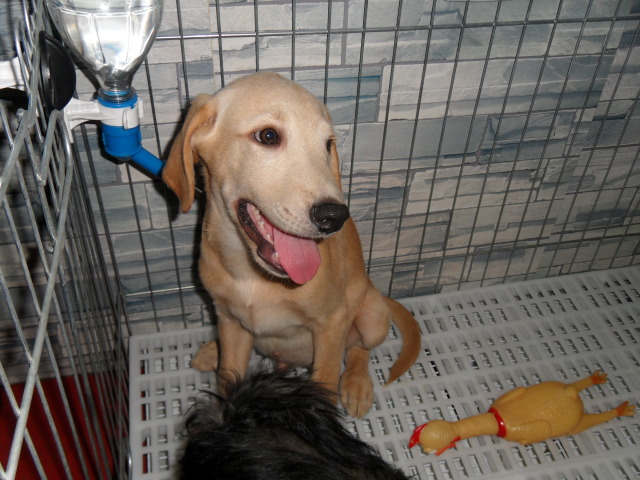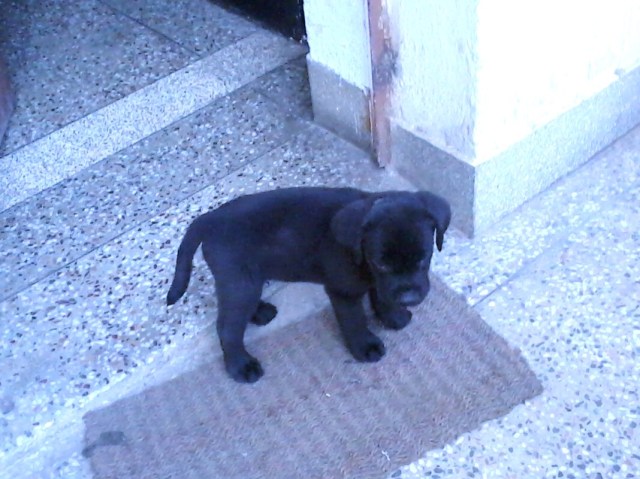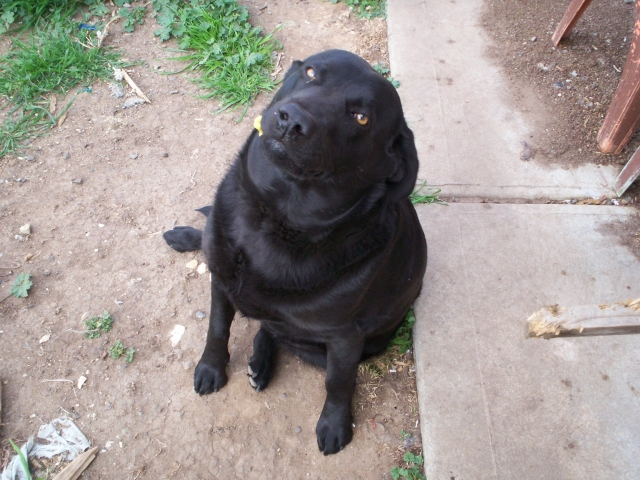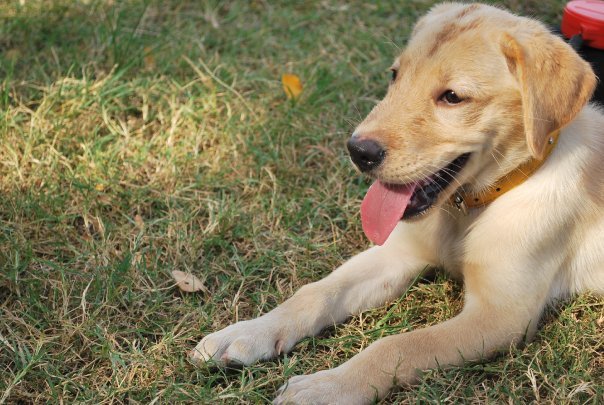QuestionIs it possible to send u a pic and see what you think as far as his breed. SOme have told me he looks like a pit. A pit and lab seem far off from each other.
As far as weight. I now only feed him twice a day about 3/4 cup full. if he was a lab. At 10-11 weeks what should he weigh? Thank you . Sorry for the questions.
-------------------------
Followup To
Question -
Hi. I recently adopted a puppy from the spca. I have been told by them he is all Lab. He is black and for sure looks like a lab. However he has the white patch on his chest. Does this mean he is a mixed? Also he is very smart at 10 weeks. I have trained hom to sit and shake. He is being crate trained. and does not poop in his crate. However I cant seem to stop him from peeing in the house and Crate. What can I do?Sorry one more questions. I was told he is very small for his age. He is 10 weeks and weighs 11 lbs. He was a very sick puppy when I received him. In the 4 weeks I have had hm he has doubled in weight. Thanks for ur help.
Answer -
Not necessarily. I can't give numbers, but some pure bred Labs are marked. It is a disqualification for a show dog, but not all dogs are bred for show. Most of the known Lab crosses I have seen were solid colored. Some time in the last year somebody here directed me to a web site with some highly marked Labs and insisted they are common. You might do a search here and see if you can find that question.
With all his other health problems, it is possible he has a bladder infection. Also some medicines cause excessive urination. You will have him in again for shots soon, ask the vet then.
In the meantime, keep a eye on him out of the crate. You may need to work more on housebreaking. This should help.
Much of housebreaking is not training the puppy, but making it easier for your
puppy, you, and your carpet while its body to catches up to its instincts. At
around 8 weeks when the puppy goes to its new home, the time from when it
realizes it has to go, and when it can't wait any longer is a matter of
seconds. Only time will fix that. You can hardly be expected to be attentive
enough to avoid all accidents There is no sense punishing the puppy for your
inattention. It is not fair to punish you either, but you still have to clean
it up if you didn't have the puppy outside in time.
Housebreaking starts before you get home with the new puppy. If you don't have
a crate, buy one. I prefer the more enclosed, den like plastic ones. Skip the
bedding. At first it gets wet, and later it can be chewed into choking
hazards. A wire rack in the bottom will help keep the puppy up out of
accidents at first. They are available with the crates, but a piece of closely
spaced wire closet shelving from a home supply place is cheaper. If you
already have a metal crate, covering it may help. Just make sure you use
something the puppy can't pull in and chew. Dogs that start out in crates as
little puppies, accept them very well. Never leave an unattended puppy loose
in the house. If nobody can watch it, put it in the crate. I suggest letting
the dog have its crate all its life.
Choose a command and spot you want it to use. The less accessible to strays,
the less chance of serious disease. If it is a female, choosing a
non grassy spot will avoid brown spots later. When you bring it home, take it
to the spot and give it the command in a firm, but friendly voice. Keep
repeating the command and let the puppy sniff around. If it does anything,
praise it. Really let it know what a good dog it is and how much you love it,
and maybe a treat. Note, being out there not only means you can praise it,
but it also keeps it from being snatched by a hawk. If it doesn't go, take it
inside and give it a drink and any meals scheduled. A young puppy will need to
go out immediately afterward. Go to the spot and follow the above routine.
Praising it if it goes is extremely important. If it doesn't go, take it back
inside and put it in its crate and try again soon. Do not let it loose in the
house until it does go.
At first it is your responsibility to know and take the puppy out when it
needs to go. It needs to go out the first thing in the morning, after eating,
drinking, and sleeping. If it quits playing, and starts running around
sniffing, it is looking for a place to go. Take it out quickly. You will just
have to be what I call puppy broke until it is a little older.
By the time most dogs are about 3 months old, they have figured out that if
they go to the door and stand, you will let them out. The praise slowly shifts
to going to the door. Some people hang a bell there for the dog to paw. If
your dog doesn't figure this out, try praising it and putting it out if it
even gets near the door. A stern "Bad dog!" is all the punishment that is
effective, and only when you catch it in the act and are sure you didn't miss
it going to the door. Clean up accidents promptly. I mostly keep the little
puppies out of the carpeted rooms. Still I need the can of carpet foam
sometimes. First blot up all the urine you can with a dry towel. Keep moving
it and stepping on it until a fresh area stays dry. A couple big putty knives
work well on bowel movements. Just slide one under it while holding it with
the other. This gets it up with a minimum of pushing it down into the carpet.
This works with even relatively soft ones, vomit, dirt from over turned house
plants, or anything else from solids to thick liquids. Finish up with a good
shot of carpet foam. Note, do not let the puppy lick up the carpet foam.
Once the dog is reliably housebroken, your carpet may need a good steam cleaning.
Many people strongly strongly push cleaning up all evidence of past accidents. I am slower to suggest that. Dogs will return to the same spot if they can find it. When you see one sniffing the spot, that is your clue to run it out.
He does sound like he is a little small, but growing fast. Be careful about feeding him too much. Most Labs will eat more than is good for them and look for more. If he doesn't have a waist, cut back a little until he does.
Thank you for adopting him. One less nice puppy to be slaughtered for lack of a home. Come back anytime for help, and I will do all I can. Adopted puppies can be difficult at times, and I make a special effort to help with them.
AnswerEasily done. Post it to one of the photo hosting sites and send me a link, or send it as an attachment to asklabman@yahoo.com. If you post it to a host site, you could then post it at http://www.k9forums.com/ and http://www.talkpets.com/ where additional good people may be able to help.
Nobody can say how much it should weigh without a hands on check. I can demo photo hosting and give you a good guide to determining how much he should weigh by giving you this link, http://www.photolocker.net/images/Labman/proplanc.jpg
I will be at a meeting tomorrow where a highly trained volunteer will be applying that method to about a dozen puppies belonging to a dog guide school.

 Is my dog a pure-bred lab?
Question
Sort of top view
Hi. I recently received
Is my dog a pure-bred lab?
Question
Sort of top view
Hi. I recently received
 labrador diet
Question
striker
i have a black male Labrador of 4 mont
labrador diet
Question
striker
i have a black male Labrador of 4 mont
 lab healthy weight
Question
Cassie
I have a black lab and she is now 3 1/2
lab healthy weight
Question
Cassie
I have a black lab and she is now 3 1/2
 vitamins for my yellow lab
Questionbruno
QUESTION: what is the best vitamin
vitamins for my yellow lab
Questionbruno
QUESTION: what is the best vitamin
 Lab eating my house! (and everything else)
Question
Pepper
I have a sweet sweet black female lab t
Lab eating my house! (and everything else)
Question
Pepper
I have a sweet sweet black female lab t